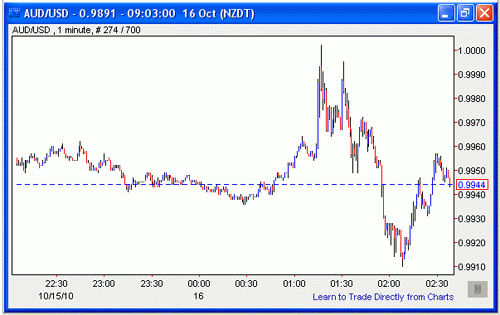
By Mike Jones*
The NZD/USD climbed to 27-month highs of nearly 0.7650 last week. Even so, the NZD still managed to take out the title of weakest performing currency.
A sliding USD bolstered demand for most of the major currencies last week. Not only did solid global data and strong corporate earnings sap demand for “safe-haven” currencies, but last week’s FOMC minutes essentially confirmed the Fed is mulling a return to monetary easing.
The associated brightening in the global outlook saw global equity markets push up to 5-month highs and the CRB commodity price index surged to the highest level since October 2008. All in all, it was the perfect recipe for continued USD weakness and the USD index recorded its fifth straight weekly decline.
Against the broadly softer USD, EUR/USD scaled 9-month highs above 1.4150 and the AUD briefly outstripped the USD in value, climbing above 1.000 for the first time since the AUD was floated in 1983. The NZD/USD was happy to head higher on the coattails of the EUR and AUD, eventually reaching a 27-month high around 0.7645.
However, more disappointing economic news took some of the shine off the NZD. The genuine softness in last week’s NZ retail and REINZ housing reports only strengthened our view the RBNZ will sit on its hands until at least March next year, tempering demand for the NZD.
This morning’s Q3 CPI will set the tone for the NZ week. We are at the top end of expectations, with 1.2% for the quarter. The market’s median expectation is 1.0% and the RBNZ had 0.9% built into its September MPS.
All up, we suspect pull-backs in the NZD/USD will be limited to around 0.7450 this week. Sure, the USD is starting to look oversold and the risk of markets being disappointed on the size of Fed quantitative easing is growing. But lofty NZ commodity prices (watch for Fonterra’s milk price auction on Wednesday) and buoyant risk appetite should ensure buyers will be found on dips.
Majors
On a trade-weighted basis the USD fell 0.4% last week, the 5th straight weekly decline. Still, after falling for most of the week, the USD steadied on Friday.
Speculation the Fed will announce up to US$1tn in additional quantitative easing (QEII) has been the main factor dragging the USD lower of late. But hopes details on the timing and size of QEII would be revealed during Fed Chairman Bernanke’s Friday speech were dashed. Instead, Bernanke simply repeated his line there is “a case for further action.”
With traders positioned for a more dovish spiel, US 10-year bond yields lifted 6bps in the wake of Bernanke’s comments (to 2.56%), imparting modest USD support.
A mixed batch of data didn’t do USD sentiment any harm either. While the US September CPI and October consumer confidence came in a smidge below expectations, September retail sales rose 0.6% (0.4% expected) and the Empire manufacturing index soared from 4.10 to 15.73 (vs. 6.00 expected).
Against the firmer USD, EUR/USD was knocked from 1.4150 back below 1.4000, GBP/USD skidded from 1.6100 to almost 1.5980 and the AUD/USD loosened its grip on parity, falling to nearly 0.9900.
Looking ahead, markets remain firmly on QE watch. How this week’s long line-up of Fed speakers influences market expectations of additional QE will be the key influence on USD sentiment this week. Current market pricing appears to reflect an expectation of roughly US$1tn in additional asset purchases in November.
Given the potential for markets to be disappointed, and already heavily short USD positioning, we suspect the pace of USD selling will slow in coming weeks.
Equally though, a sustained USD rally is unlikely ahead of the November 3 FOMC meeting.
Indeed, Fed officials Evans (non-voter) and Rosengren (voter) both argued for further aggressive action by the Fed at a conference over the weekend. Evans (Chicago Fed President) said "much more policy accommodation is appropriate today." We wouldn’t be surprised to see the USD start the week on the back foot as a result.
Besides Fed rhetoric, there is plenty of other event risk to keep an eye on this week. In particular, RBA and Bank of England minutes, a policy announcement from the Bank of Canada, the September Chinese data ‘dump’ and Friday’s German IFO confidence index will all be worth watching. Finance Ministers from the G20 are also gathering on Friday, where talk of “currency wars” looks set to dominate the agenda.
* Mike Jones is part of the BNZ research team.
All its research is available here.
We welcome your comments below. If you are not already registered, please register to comment
Remember we welcome robust, respectful and insightful debate. We don't welcome abusive or defamatory comments and will de-register those repeatedly making such comments. Our current comment policy is here.